Ifrane itself, lies over 5,400 feet above sea level. The name "Ifrane" in Berber means "caves" and the original settlements were hollowed out of the local limestone hills and valleys. Under the French colonial era, Ifrane became a "hill station", a place for colonial folks to retreat during the hot summer months. Today, it is what they call a "garden city", a mountain resort, and a college town. In 1995, the Al Akhawayn University opened its doors as a modern institution of higher learning, modelled in every way on the American University System. Classes are taught in English, the student body is international.
Today, Ifrane is also a winter paradise, a ski town that attracts skiers from all over Europe and beyond. Plenty of snow falls in winter, which explains why all the buildings have deeply pitched roofs, giving you the feeling you are in Switzerland, not Morocco!
The same scene in early June is lush and green, with several parks where fountains play...
...and the ubiquitous sign in Arabic asks you to "keep off the grass!"
A local landmark features a lion's head carved out of a chunk of limestone in the 1930s. A reminder of the wild Barbary Lions, one of the biggest lion sub-species, that once roamed the Atlas Mountains. They were reputedly still in evidence in Morocco until the 1960s, but now, alas, are considered extinct in the wild.
Happily, the weekly souk occurred on my first day in Ifrane, so whilst Matthew was busy with his script meetings, I got a ride with Shaqib to go check it out. When you drive down from Ifrane to the lower areas of this part of Morocco at this time of the year, your eyes are constantly dazzled with acres and acres of blooming red poppies, stretching to the horizon. Almost like a mirage at times.

The souk takes place on the outskirts of Azrou, covering several acres of sprawling tent stalls, and on this warm Tuesday morning, packed with shoppers and merchants.
We began at one end, and slowly meandered our way through the aisles. I was so impressed at how this stall holder managed to display their rugs and blankets without any table or tent, just by turning them into pillars of bright colors and patterns.
These sacks of spices gave off such fragrances, you really had to stop and "sniff" it all in!
Some stalls covered a range of items, dates, nuts, pottery, leather handbags...
...whilst this one devoted its entire space to RAT POISON, Yikes!
This sweet young man spoke Arabic and some English, but very little French. He comes here every week and sets up his trusty Singer sewing machine (treadle foot!). Customers line up with clothing that needs alterations, or repairs, he'll even sew up a metre or two of cloth into a garment for you.
Meanwhile, Shaqib tried to persuade me to buy this giant couscoussière!
I was more interested in the pretty tea services, the metal tea pot and the lovely glasses for serving the delicious Moroccan mint tea. I ended up with a dozen glasses!
And I was always drawn to the stalls displaying women's tunics and dresses in rich fabrics and bright colors.
It was, however, pretty evident that not all the bright colors were on hangers in the stalls!
At the far end of the souk, was another world entirely -- livestock for sale! Mostly sheep, although there were a few cows, goats and chickens.
The whole of the Mid-Atlas Region is spilling over with sheep -- on the hills, grasslands, along the roads, but it was still quite amazing to see so many here on display, for sale. And I loved how each shepherd joined his little flock together, noses in, tails out!
Once the sale is concluded, the new owner leads the sheep away and loads them onto his truck.
Looks like one got left behind here! I never quite understood whether the sheep were being sold for meat, or for wool, or for augmenting an existing flock, but all I can say for sure is that there sure are a lot of sheep in this part of the world!
Before we left the market, Shaqib made a point of stopping by this man's stall and buying a large bag of peanuts. Maybe he needs a snack, I thought.
A short drive back into the mountains, and I realized that it was not Shaqib who needed a snack. We were headed to the Gourad Cedar Forest, a national forest where people can go hiking, trekking or camping. And it is also home to the endangered Barbary Macaque Apes (called "magots")!
We stopped by the side of the road, and out they all came, and immediately began gobbling up all the peanuts!
They are obviously used to this "free lunch" and made themselves quite at home.
In fact, it took starting up the car's engine to encourage this young monkey to hop off and go back to his/her troop!
The following morning, Matthew had no meetings, so, again Shaqib very kindly drove us down from the mountain top, this time to Meknès, one of the four imperial cities of Morocco, and today the sixth largest city in the country. It is named after a Berber tribe, Miknasa (Imeknasan in the Berber dialect, Tamazight), who settled the area in the 9th century.
Over the following centuries, the city fell under different rulers, until the 17th/18th century -- its so-called "golden era" -- when it was designated the imperial capital of Moulay Ismail, who became Sultanate of Morocco in 1672 and ruled until 1727. Under his regime, he built mosques, gardens, walls to protect the city and monumental gateways. This one, the Bab Mansour gate, was completed after his death. The "zellij" mosaics are stunning, the white marble columns come from the Roman ruins of Volubilis, some 30 minutes outside Meknès.
Another of Moulay Ismail's grand constructions were his Royal Stables, built to comfortably house no less than twelve thousand of the royal horses! He was apparently so devoted to these animals, that each one had a slave and groom to attend to their every need. Alas, during the 18th century, an earthquake in Lisbon, Portugal was so severe its shock waves rippled powerfully all the way to Meknès, and destroyed these stables! Even in its ruined state, the size and scope of the construction is jaw-dropping.
Concerned about food for his horses, Moulay Ismail built a granary, known as the Water Palace (Der el Ma), behind the royal stables. Constructed on top of a reservoir, they were designed to be able to store grain to feed all twelve thousand horses! The size of this sprawling complex actually allowed the granaries to store enough grain to feed the horses for twenty years!
A super voluble guide, almost literally "ran" us through the granary, spilling out so much information that we could barely keep up with him. To keep the grain cool and dry, the walls were incredibly thick, and a suspended forest was grown on the roof. Water from the reservoir below, was forced through ducts in the floor, to maintain a low temperature and keep the grain from rotting. Such was the devotion of Moulay Ismail for his horses! And such was the technology and ingenuity in Meknès in the late 17th/early 18th century.
Back outside, we had time for one more stop: the food market in a souk across from the Bal Mansour Gateway. But first, we had to admire this fellow's incredible display of tagine pots and other ceramics.
Inside the food market, shoppers crammed the aisles, as did we, mouths watering at all the offerings...
...chili peppers, nuts and spices...
...endless displays of sweets and cookies, just waiting to be enjoyed with one of those nice glasses of Moroccan mint tea!
Several aisles were devoted to meat in all its forms. In spite of the strong stench, people patiently awaited their turn.
This shop keeper is grinding meat into patties, behind a huge side of beef...
...whilst this stall offered pigs' trotters, along with parts of animals that were unknown to us...
...whole cows' heads were up for grabs here...
...or, if you preferred, goats' heads! Clearly, every part of every animal has a value and finds a home.
After all those images (and smells!), you might think that we would have lost all appetite to ever eat again, but somehow we were easily seduced by this lovely woman's warm smile, and enjoyed a delicious and very traditional tagine at a roadside cafe on our way back to the mountains and Ifrane!
Our last day, and we headed down to Fez, to spend the day and the night in the famous, labyrinthine medina. But first, we climbed a rocky hill outside the city, where ruins from an ancient fort still stand.
Turning around, we then looked down over the sprawling city of Fez, the second largest city in Morocco, and one time capital city of Morocco. A guide -- who spoke the most immaculate, clear French so that I could understand almost every word -- gave us a great précis of the history of the city, dating back to the 8th century. (There were several Idris leaders during the Idrisid dynasty at that time -- Idris Elba, anyone!). The Arabic word Fa's means pickaxe, and legend has it that Idris I of Morocco used one (made of silver and gold) to define the lines of the city, giving it its eventual name, Fez. Then came the Marinids and their dynasty, various caliphates, the Ottoman Empire, Spain, Portugal and then the French. A classic polyglot of conquest and civilizations along the myriad trade routes of history.
Coming back down from the mountaintop view, we left our "wheels" in the modern world, and headed down into what has been called one of the largest urban pedestrian-only areas in the world, the Fez medina. The word "medina" means city, and with its winding narrow alleyways, the walk through the Fez Medina is truly a walk back into time – a complicated labyrinth built, at the time, to thwart invasions. Walking through it today makes you feel like you are experiencing a picture of medieval Islamic society, set in modern times.
Right away, you find yourself trying to look all ways at once, in order not to miss a single image, face, color, sound.
Then, just as the alley narrows down, you sort of narrow down your focus, and you find yourself seeing very specific people and things.
As if we hadn't seen enough of every kind of livestock, we found, right away, butchers galore, and chickens tethered to a table top, patiently waiting for their fate!
We marvelled at all the musical instruments...
...at all the rugs: "they can be shipped to France within 48 hours"! We said we'd think about it...
...the very pretty pottery -- we did indulge here!
And we were modest in the world of leather -- one belt only!
In the end, it was always the faces that caught the eye, this man pouring himself a glass of mint tea...
...the egg seller, sitting on his stool by an open door...
...this veiled older woman, who has perhaps walked through the medina every day of her life.
Then, there were glimpses at the world of Islam. One of several mosques in the medina had open walls...
..but entrance was "interdit" to non-Muslims, alas. It looked very beautiful.
And then, there was this plaque, a tribute to the presence in the 13th century of a hospital on this site, built by the Merindins, that led, a few centuries later, to the first psychiatric facility in the western world in Valencia in the 15th century. This hospital was still open and operating until 1944. What a story!
As well as normal, every-day items to buy in the medina -- or not to buy -- there are also specialized items, things that perhaps you buy once in a lifetime, like these "bridal belts"...
...that would be worn by the bride when she rides in this "bridal chariot", carried through her town, that is also for sale in the Fez Medina!
Along with all the commerce and the mosques, there were also several Madrassas -- their entrances seemed like a quiet invitation to some more tranquil world.
And, in fact, one of them was open to the public, and offered a quiet moment in the midst of the busy world outside.
At the end of the day, after a few hours of being in a massively intense world, it was time to wander slowly down some quiet, narrow streets to our overnight riad...
..Riad le Jardin des Biehns...
...where, with our dear friend, Jean-Luc (who organized the workshop in Ifrane) and his lovely friend, Hélène, we spent a most delightful evening and night...
...in this beautiful oasis. What a memorable week!
À bientôt!






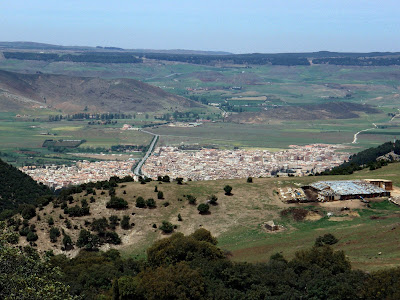

























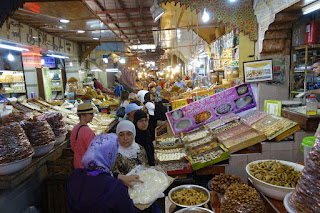




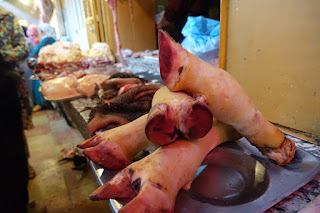









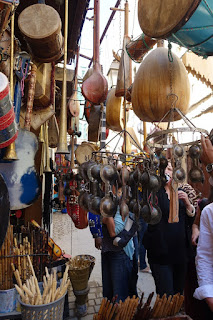






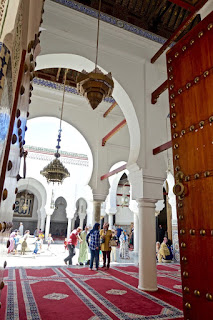











What an adventure. How terrific for you both. I can still remember the photograph of Matthew ordering our dinner for one evening. Pigeon Pie. But I don't think the Pigeons were waiting as patiently as your chickens. mxm
ReplyDeleteAs always, a magnificently photographed escapade with terrific insights into the culture, sights and foods of this wonderful country. And congratulations on the arrival of the newest member fo the Robbins clan!
ReplyDeleteThanks Rick, just catching up with this. Best to you and Randi as well! Janet
DeleteMost enjoyable reminder of my visit to Morocco in 1978.
ReplyDeleteMarty Rayman
So nice to read your comment, Marty, thank you! It was a really memorable week. Best to you, Janet Robbins
Delete